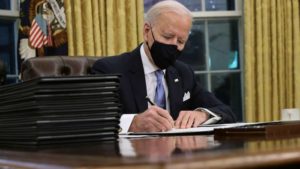Having campaigned on promises to be the most pro-union president ever, President Biden held fast to his commitment on April 26, when he signed an Executive Order (EO) establishing the White House Task Force on Worker Organizing and Empowerment.
The Task Force will be “dedicated to mobilizing the federal government’s policies, programs, and practices to empower workers to organize and successfully bargain with their employers,” read a statement from the White House.
Vice President Kamala Harris will act as chair of the Task Force with Labor Secretary Marty Walsh acting as vice-chair. The Task Force will include more than 20 cabinet members and heads of federal agencies.
The President’s Executive Order directs the Task Force to make a set of recommendations within 180 days addressing two key issues: how can existing policies, programs, and practices be used to promote worker organizing and collective bargaining in the federal government; and where are new policies needed to achieve the Task Force’s mission and what are the associated regulatory and statutory changes needed?
According to the White House Statement, the Task Force will engage with a diverse set of leaders in the labor movement, academia, advocacy groups, and beyond to “seek ideas for potential federal action and feedback on initiatives under consideration.”
The following day, Biden again used his executive powers to raise the wages of more than 390,000 federal contract employees.
Beginning January 30, 2022, all agencies will need to incorporate a $15 minimum wage in new contract solicitations, and by March 30, 2022, all agencies will need to implement the minimum wages into new contracts. Agencies must also implement the higher wage into existing contracts when the parties exercise their option to extend such contracts, a common practice.
The EO also requires that the minimum wage be indexed to an inflation measure so that each year after 2022 it will be automatically adjusted to reflect changes in the cost of living.
In the circumstances where federal contractors’ employees earn a tipped minimum wage, the EO eliminates that sub-minimum by 2024. Those employees will then earn the same minimum wage as other employees on federal contracts.
Finally, the EO addresses workers with disabilities, requiring they too earn a $15 minimum wage. ■




